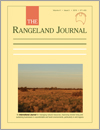RJ18070Plant litter decomposition in a semiarid rangeland of Argentina: species and defoliation effects
Plant litter production is important in nutrient cycling and ecosystem productivity, whereas organic matter loss from litter might be affected by defoliation, and the plant canopy. Aboveground litter production by area unit was similar between three grasses; however, leaf blade decomposition rates were higher in desirable than undesirable grasses. The opposite was true for belowground litter. Moderate defoliation did not affect organic matter decomposition, and the presence of desirable grasses promoted litter decomposition, a key factor in determining soil fertility in terrestrial ecosystems.





